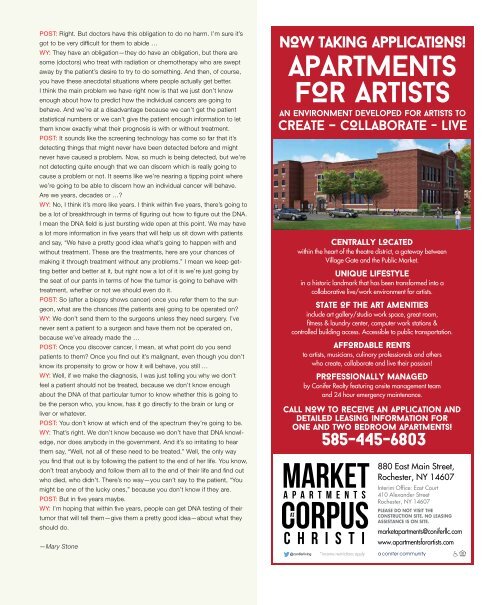Create successful ePaper yourself
Turn your PDF publications into a flip-book with our unique Google optimized e-Paper software.
<strong>POST</strong>: Right. But doctors have this obligation to do no harm. I’m sure it’s<br />
got to be very difficult for them to abide …<br />
WY: They have an obligation—they do have an obligation, but there are<br />
some (doctors) who treat with radiation or chemotherapy who are swept<br />
away by the patient’s desire to try to do something. And then, of course,<br />
you have these anecdotal situations where people actually get better.<br />
I think the main problem we have right now is that we just don’t know<br />
enough about how to predict how the individual cancers are going to<br />
behave. And we’re at a disadvantage because we can’t get the patient<br />
statistical numbers or we can’t give the patient enough information to let<br />
them know exactly what their prognosis is with or without treatment.<br />
<strong>POST</strong>: It sounds like the screening technology has come so far that it’s<br />
detecting things that might never have been detected before and might<br />
never have caused a problem. Now, so much is being detected, but we’re<br />
not detecting quite enough that we can discern which is really going to<br />
cause a problem or not. It seems like we’re nearing a tipping point where<br />
we’re going to be able to discern how an individual cancer will behave.<br />
Are we years, decades or …?<br />
WY: No, I think it’s more like years. I think within five years, there’s going to<br />
be a lot of breakthrough in terms of figuring out how to figure out the DNA.<br />
I mean the DNA field is just bursting wide open at this point. We may have<br />
a lot more information in five years that will help us sit down with patients<br />
and say, “We have a pretty good idea what’s going to happen with and<br />
without treatment. These are the treatments, here are your chances of<br />
making it through treatment without any problems.” I mean we keep getting<br />
better and better at it, but right now a lot of it is we’re just going by<br />
the seat of our pants in terms of how the tumor is going to behave with<br />
treatment, whether or not we should even do it.<br />
<strong>POST</strong>: So (after a biopsy shows cancer) once you refer them to the surgeon,<br />
what are the chances (the patients are) going to be operated on?<br />
WY: We don’t send them to the surgeons unless they need surgery. I’ve<br />
never sent a patient to a surgeon and have them not be operated on,<br />
because we’ve already made the …<br />
<strong>POST</strong>: Once you discover cancer, I mean, at what point do you send<br />
patients to them? Once you find out it’s malignant, even though you don’t<br />
know its propensity to grow or how it will behave, you still …<br />
WY: Well, if we make the diagnosis, I was just telling you why we don’t<br />
feel a patient should not be treated, because we don’t know enough<br />
about the DNA of that particular tumor to know whether this is going to<br />
be the person who, you know, has it go directly to the brain or lung or<br />
liver or whatever.<br />
<strong>POST</strong>: You don’t know at which end of the spectrum they’re going to be.<br />
WY: That’s right. We don’t know because we don’t have that DNA knowledge,<br />
nor does anybody in the government. And it’s so irritating to hear<br />
them say, “Well, not all of these need to be treated.” Well, the only way<br />
you find that out is by following the patient to the end of her life. You know,<br />
don’t treat anybody and follow them all to the end of their life and find out<br />
who died, who didn’t. There’s no way—you can’t say to the patient, “You<br />
might be one of the lucky ones,” because you don’t know if they are.<br />
<strong>POST</strong>: But in five years maybe.<br />
WY: I’m hoping that within five years, people can get DNA testing of their<br />
tumor that will tell them—give them a pretty good idea—about what they<br />
should do.<br />
—Mary Stone<br />
NOW taking applicatiOns!<br />
Apartments<br />
fOr Artists<br />
an environment developed for artists to<br />
Create – COllaborate - Live<br />
Centrally LOcated<br />
within the heart of the theatre district, a gateway between<br />
Village Gate and the Public Market.<br />
unique Lifestyle<br />
in a historic landmark that has been transformed into a<br />
collaborative live/work environment for artists.<br />
state Of the art amenities<br />
include art gallery/studio work space, great room,<br />
fitness & laundry center, computer work stations &<br />
controlled building access. Accessible to public transportation.<br />
affOrdable rents<br />
to artists, musicians, culinary professionals and others<br />
who create, collaborate and live their passion!<br />
prOfessionally managed<br />
by Conifer Realty featuring onsite management team<br />
and 24 hour emergency maintenance.<br />
call nOw to receive an application and<br />
detailed leasing information for<br />
one and two bedroom apartments!<br />
585-445-6803<br />
*income restrictions apply<br />
880 East Main Street,<br />
Rochester, NY 14607<br />
Interim Office: East Court<br />
410 Alexander Street<br />
Rochester, NY 14607<br />
PLEASE DO NOT VISIT THE<br />
CONSTRUCTION SITE. NO LEASING<br />
ASSISTANCE IS ON SITE.<br />
marketapartments@coniferllc.com<br />
www.apartmentsforartists.com


